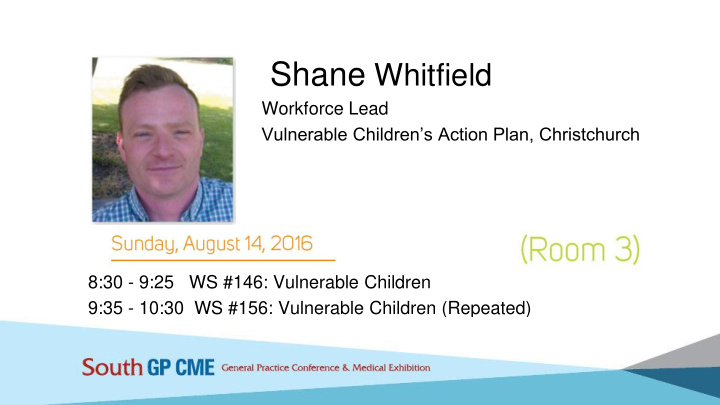



Shane Whitfield Workforce Lead Vulnerable Children’s Action Plan, Christchurch 8:30 - 9:25 WS #146: Vulnerable Children 9:35 - 10:30 WS #156: Vulnerable Children (Repeated)
South GP Conference and Medical Exhibition August 2016
Our past informing our future The Children’s The Green Paper The White Paper Action Plan Almost 10,000 White Paper is based Implements the submissions on these decisions made in received. submissions. the White Paper. From children, It contains what young people, changes are needed frontline workers, to protect children and NGOs. from harm.
What did the Community ask for? • Better sharing of information and communication. • Concern about statutory responses • Better identification and support for most vulnerable • Higher levels for safety and competency of workforce • Increased recognition that everyone needs to be responsible for keeping children safe.
The Children’s Action Plan taking the lead for vulnerable children A safe, competent and well-connected children’s workforce, which identifies vulnerable children early, and supports them to be safe, thrive, achieve and belong.
A Children’s Action Plan – for change Key work streams from the Action Plan: • A safe and competent workforce ( vetting and screening, child protection policies, core competencies • Intensive cross-agency support ( Children’s Teams ) • Early identification & triaging (The Hub/ViKI/AISA)
Vulnerable Children Defined ... “Vulnerable children are children who are at significant risk of harm to their wellbeing now and into the future , as a consequence of the environment in which they are raised , and in some cases, due to their own complex needs . Environmental factors that influence child vulnerability include not having their basic emotional, physical, social, developmental and/or cultural needs met at home or in the wider community. ” Source: Cabinet Social Policy Committee (2012:9) White Paper for Vulnerable Children. Wellington: Office of the Minister for Social Development.
The Vulnerable Children Act (2014) • Signaled major changes in the way vulnerable children are identified, protected and nurtured. • Introduced clear accountabilities and strong direction for the children’s workforce. • Is the biggest change since the Children, Young Persons and their Families Act was introduced in 1989.
The Children’s Team Approach • Child focused - The child at the centre of everything we do. • Trans-disciplinary - Joined up support, intervening early. • Strongly connected - Working together, sharing information.
Information Sharing • The Vulnerable Children’s Hub • Vulnerable Kids Information system (ViKI) • Approved Information Sharing Agreement (AISA) • - S.15 protects referrer from any action (good faith) • - Privacy Principle 11 (f)(ii) allows information to be shared
Children’s Workforce • Safety checking • Child protection policy • Core competencies
Working in Silos One children’s workforce One agency responsible Shared responsibility Individual competence Collective competence Service driven Child centred
Children’s Teams making the difference Working better together leads to better results for the child: • Earlier support and services • The more in-depth, trans-disciplinary assessment provides more information about the child and what they need • The mix of services wrapped around each child and their family/whānau changes and adapts, as their needs evolve
Investing in Children - Expert Panel Report • Government’s response for the future of care and protection and the system-wide transformation • Focus on five core services: • prevention, • intensive intervention, • care support services, • transition support • youth justice service aimed at preventing reoffending. • Supports what Children’s Action Plan is already doing and strengthens and expands our approach.
www.childrensactionplan.govt.nz
Recommend
More recommend